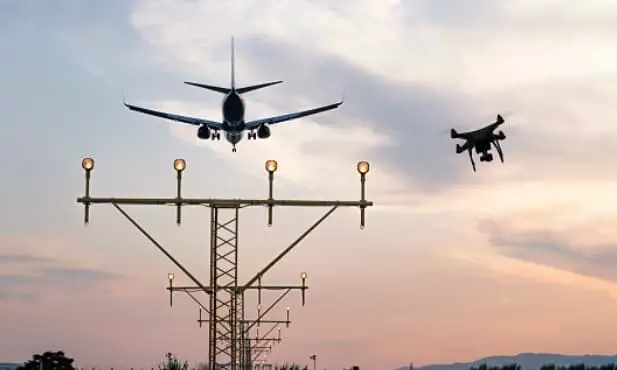
The other day I happened to be flying just outside a No-Fly Zone and thought to myself, “If I entered the zone would I be picked up on radar?” Well, I did some research, and here is what I found.
Radars can detect hobby size drones, but only if it’s designed specifically for this purpose. Ultimately it would depend on the radar’s settings. Most of the time, radars are designed to signal the locations of larger aircraft, while classifying smaller objects like hobby drones and birds as simple clutter.
Since radars mostly ignore drones, are there other ways to detect them? Keep reading to find out.
How To Detect Drones In Your Area
Because of the recent rise in drone technology and the popularity of these drones making them more accessible to the average consumers, many people are now wondering how will they know when people are trying to spy on them using the very drones that were meant for fun entertainment and video capturing.
Like myself, you might be really afraid of what can happen in the future and how you can defend yourself against this rising threat.
Radars are expensive compared to RF sensors and have some limitations like a field of view, and the range of detection.
To achieve full and complete 360-degree coverage using only radar sensors is expensive. Because of this very reason, radars are best used as an additional layer over a critical area, alongside RF sensors and Visual detection which is a lot more cost-effective while offering complete coverage.
There are also different applications that are able to turn your cellular device into a sort of radar and detect drones that may or may not be in the area spying on you.
Drone Watcher App.
This app turns your regular smartphone or tablet device into a drone and small UAV detector that detects, tracks, alerts and records information on almost all types of drones using advanced signal detection technology.
Commercially-available consumer and prosumer drones are harder to track normally, but with this radar app, it makes it easier to detect, track, and alert you about the drone type and ID. This can then be used to document incursions and support apprehension and prosecution by local law enforcement.
The DroneWatcher APP runs in the background and only provides alerts when a drone is detected within its monitoring range, which is around a 0.5-mile radius. This is extremely useful and will be the first defense against people using the drones to spy on you.
The DroneWatcher APP can also be installed and operated on non-cellular Android tablets as long as the device is connected to a local WiFi network. This basically makes it serve as a kind of home security system for drones.
Aveillant.
This is similar to the DroneWatcher App but is also a one-of-a-kind Counter Drone system that works by detecting and tracking drones in surrounding airspace and alerting airports of unauthorized drone use quickly and efficiently. This new and innovative system also works to locate the drone pilots themselves and can be used to identify their location.
The Thales company specifically designed Aveillant to assist Heathrow Airport and the tech comprises of a variety of leading counter-drone technologies.
Drones And Radars
As drones become more and more accessible to the average consumer, it raises many questions about how high-risk facilities will be able to deal with the new risks.
Drones are small, aerial objects that can be flown over areas and used to take footage or photos of the surrounding areas. Most people use drones to record videos and take pictures.
But, in the wrong hands, drones can be used for surveillance and terrorism by people who wish to do harm to other people.
Sounds a little ominous, right? Before you freak out, let’s dig a little deeper into this so get a better understanding.
How Do Radars Work?
Radar systems work by emitting short pulses of signal known as Radio Frequency Waves or Radio Waves. Bats use a similar method called echolocation to bounce frequency waves off of walls and various objects so they know what is in front of them in order to avoid objects.
In the same way, radars work by sending frequency waves out. If there is an object in the way of the signal, the echoes or reflections of the signal are captured by the radar antenna and amplified to identify the nature or shape of the object.
Radars continuously scan the sky looking for reflections and changes to detect movement and size. Reflected signals can be compared to a database for object characterization.
Radar technology has been a huge help in helping authorities to identify, and locate manned, larger, or long-distance aircraft flying within the airspace.
How Far Can Radars Detect Drones?
The distance at which a radar can detect a drone all depends on the drones Radar Cross Section (RCS). Drones that have a larger RCS will be able to pop up a lot earlier on the radar than a smaller drone with a smaller RCS.
From previous tests that have been done, we know that drones the size of a Phantom 4 can be detected from about a mile away. The range at which a drone will be detected also depends on the size of the drone.
Another thing that affects the distance at which a drone is able to be detected by radar is the different weather conditions in the area, such as rain and fog.
Radars can detect all types of drones regardless of whether it uses RF communication, GPS pre-programming or WiFi/Cellular communication—this is important to state because the only thing that limits the detection of a drone is the size.
Can The Police Track Your Drone?
As there are more and more drones flying around in the sky the main aviation regulator in the US wants to be able to keep a closer eye on each of them.
At the moment the police cannot track your drone, but a proposed rule by the FAA would allow police to be able to track drones in real-time. This includes the police and any other relevant government agencies.
The FAA (Federal Aviation Administration) has proposed a rule that will need most drones to have remote IDs that would let officials track them in real-time.
The rule would apply to all drones required to register with the FAA, which means recreational drones weighing at about 0.55 or less would be exempt from this rule. This rule is not just to keep an eye on all the drone enthusiasts in the country but there are other reasons why this rule needs to be implemented.
Drones are handling a lot of different jobs all around the world such as film making, monitoring oil refineries, surveillance for the military as well as search and rescue. Companies like Amazon are working on delivery drones as well as the UPS. This will make it a lot easier to do deliveries.
One thing that has been on the rise is crime using drones. Criminals are using drones to transport drugs and weapons which is the main reason why this rule needs to be implemented.
With this tracking and drone radar technology being used together, anyone flying near or around an area they are not supposed to be flying in can be located, ID identified and finally tracked to wherever the drone came from and who it belongs to.
It may seem like an invasion of privacy but like all other trackers in all other techs, it’s needed to keep other people safe!
